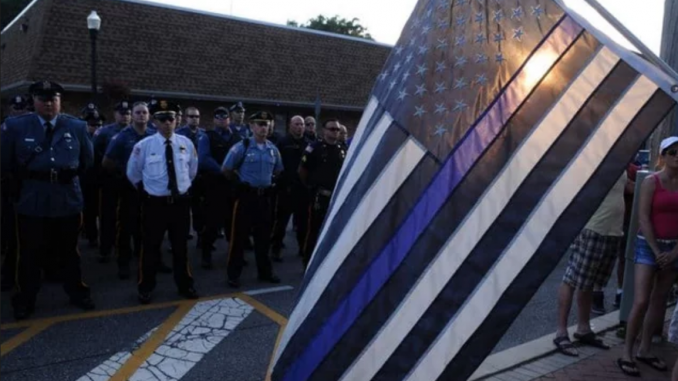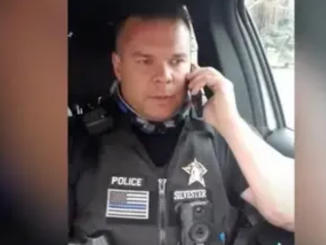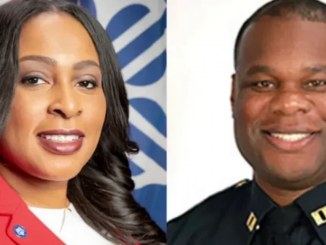
The Solon Police Department announced this week that it would no longer fly the “Thin Blue Line” flag on its property, citing a wave of public criticism from city residents.
Solon police Chief Richard Tonelli posted a letter on Facebook Tuesday announcing the removal after flying the flag at the department for five weeks.
“During the time it was up, it caused a divisive and unhealthy reaction within our community,” he wrote in the letter. “It is unfortunate that the thin blue line imagery has been associated with extreme and dismissive views that are counter to our values; nonetheless, we are sensitive to the fact that it alienates us from those we are committed to serve and protect.”
The now-familiar flag is a black-and-white version of the American flag with a bright blue strip down the center began its life as a popular way for people to show support to law enforcement. However, its meaning evolved over time and in the wake of social justice movements and increased criticism over Black Americans’ historical and continued mistreatment by police.
Tonelli’s announcement sparked both support and backlash from some residents who are not thrilled by the chief’s decision.
“I don’t (know) how or why everyone is caving to a few people who are upset,” one Facebook user wrote beneath Tonelli’s post. “This is unfair to all the police and their supporters, and I’m disappointed in this decision and that we are not standing up for our beliefs.”
On the other hand, some residents said they are proud that the chief and the city listened to the criticism and decided to remove the flag.
“I support the Solon Police, but a flag that was designed in 2014 as a response to the protests of the violence used against Tamir Rice, Eric Gardner, and Michael Brown will only serve to divide the community, ultimately making the job of the police more difficult,” another responder wrote.
Chenelle Jones, chairwoman of the public safety programs at Franklin University in Columbus, applauded the Solon department’s move.
“This is really an opportunity for Solon to take a proactive step in improving police-community relations, and is also an opportunity for the city citizens of Solon to lean into improved fully police-community relations in supporting their police departments,” she said. “If they are so patriotic, then at this moment, what they need to be doing is supporting the decision of the chief of police and the department in their decision.”
Jones added that any additional unrest that might stem from the flag’s removal would point to a deeper underlying racialized issue within that community that needs addressing.
“A lot of people don’t understand the history of that thin blue line flag, or because of their lived experiences, they don’t realize that it’s possible that communities of color, especially black and brown communities, may have had adverse effects and negative experiences within law enforcement,” she said. “So just stepping outside of ourselves and being able to expand our worldview to realize that there are different lived experiences amongst different populations.”
Jones points out that people and businesses in communities like Solon tend to have more positive experiences and relationships with police. Some residents engage with police regularly, or the officer may be a relative, and in some instances, the resident has never experienced police harassment or arrest.
However, residents in certain pockets of Cleveland and other cities may not have those same positive experiences with police. Instead, they might experience harassment by being followed by police or have family or friends who suffered abuse at the hands of police.
“Those two different experiences could create so much confusion and misinformation around that thin blue line flag,” Jones said. “And that’s why many departments recognize those mixed messages that are often associated with the flag and have now decided to start removing it.”
The origin of the flag dates to an 1854 battle during the Crimean War. A British infantry regiment in red uniforms stood up against a Russian cavalry charge. The British configuration became known as the “Thin Red Line.” The phrase “Thin Blue Line” eventually came to serve the idea that police serve as an arm of society that keeps it from descending into chaos.
The now-popular flag dates back to 2014. A Michigan college student named Andrew Jacob thought the protests for Rice, Gardner, and Brown in Ferguson against police violence were outrageous, so he started Thin Blue Line USA, a company dedicated to selling pro-police merchandise.
Members of law enforcement and their supporters would place the thin blue line flag on their police cruisers, uniforms, and in the windows and on the desks in their office in solidarity. What started as a show of support for police evolved in August 2017 when it appeared at the Unite the Right Rally in Charlottesville, Virginia, where members of the alt-right carried the thin blue line flag alongside the Confederate flag.
The alt-right and white supremacists organized the “Unite the Right” protests in opposition to removing a statue of Confederate General Robert E. Lee. A counter-protester died after a man drove his car into a group of people during the protest. Its presence at the rally began its association with far-right hate groups. It became a fixture at Trump rallies and in the arms and on the shirts of counter-protesters of anti-racism and Black Lives Matter demonstrations across the country.
The flag also made several appearances at the Jan. 6 insurrection when supporters of former President Donald Trump stormed the U.S. Capitol. Rioters climbed walls, broke windows, and damaged property as they carried Confederate flags and thin blue line flags.
The recent deaths of George Floyd, Daunte Wright, Breonna Taylor, and others at the hands of police continue to thrust the historically troubled relationship between Black and Brown residents and police into the public consciousness keeping race in the center of the American political conversation.
“We know that officers engage in misconduct, and rarely are they held accountable for their actions, and there is oftentimes a lack of transparency within departments across the country,” Jones said. “But at some point, in time, everybody needs to realize that we can’t be policing and doing things the way that we were in the past.”
Solon’s Mayor Edward Kraus released a statement that the police department will be replacing the flag with the National Law Enforcement Memorial flag.
“I appreciate Chief Tonelli’s openness and initiative in securing the National Law Enforcement Memorial flag for display on police grounds. Our citizens will find this flag, whose sole purpose is memorializing those who lost their lives in the duty of service, to speak for supporting our great and honored Police Department,” Kraus said in a statement.
*story by American Military News


